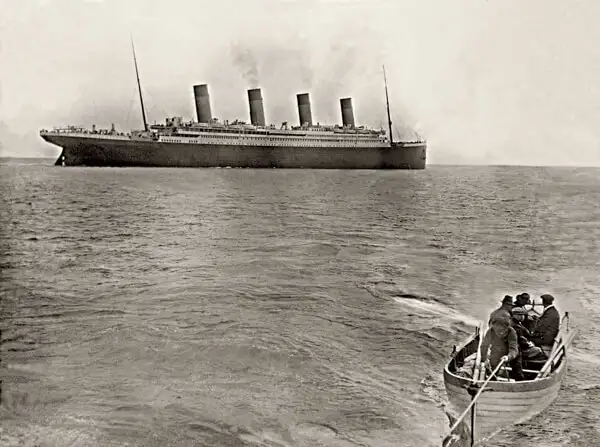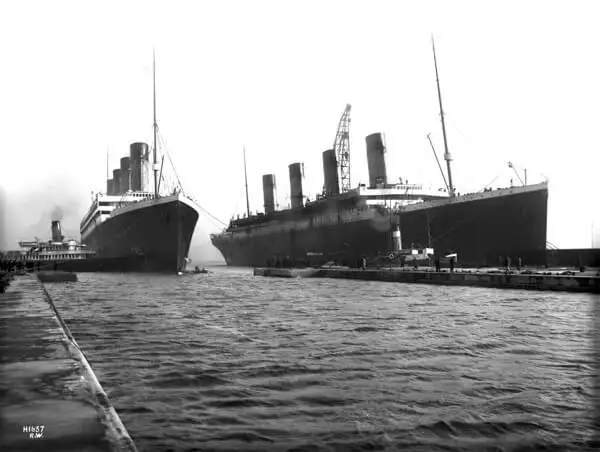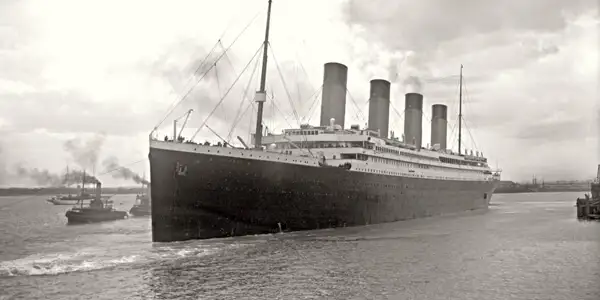Belfast was one of the major centres of shipbuilding in Europe from the 18th to the early 20th century. Among other things, the Titanic was built here, as well as her sister ships, the Olympic and the Britannic.
Page Contents (click line to jump the text)

Intro
In Belfast you will find the Titanic Experience, which is a large exhibition about the Titanic and the time when shipbuilding flourished in Belfast. The Titanic Experience is probably one of the most important sights in Belfast, if not the most important.
Quite rightly so, in my opinion. My wife and I visited the Titanic exhibition on a tour of Northern Ireland and were very impressed.
The exhibition is very entertaining and varied and is not only about the tragic sinking of the Titanic, but also about the construction of the ship, the life of the workers in the shipyards and Belfast itself.
Belfast is a multi-layered city and here you get a good introduction to it.

The Titanic Experience
The Titanic Experience has a purpose-built building and was only opened in 2012. It is located in Belfast harbour, on the site of the Harland & Wolff shipyard that built the Titanic. The neighbourhood is also known as the Titanic Quarter.
In addition to the easily recognisable silver exhibition building, you will find the Titanic’s dry dock and the berth of the SS Nomadic, a museum ship that you can also visit.
The Titanic exhibition is large and extensive. You should therefore bring enough time with you. We certainly spent over two hours in the exhibition, but you can easily spend half a day there if you are interested in all the details.
You can find more information about the Titanic Experience Belfast here: https://www.titanicbelfast.com/.

A brief overview of Belfast
Anyone who heard about the Northern Ireland conflict in the news in the 1970s would associate the city of Belfast primarily with bomb attacks and civil war-like conditions. Today, tourists need not fear such unrest.
But let’s look further back into the past: human settlements had already existed here for a long time when a Norman castle was built here in the city area of modern-day Belfast around 1177. But it was not until 1603 that the city was founded.
Due to ongoing rebellions in Catholic Ireland, the English Crown actively supported the settlement of Protestant Englishmen and Scots in the region and in the city, thus laying the foundations for the founding of Northern Ireland and the secession from Ireland in 1921.
In the 19th century, the harbour was expanded in the course of the flourishing shipbuilding industry and during the Second World War, it and the city itself were massively damaged by bombing by the German Luftwaffe.
In 1969, the “troubles” began in Belfast, i.e. the aforementioned Northern Ireland conflict, which was only officially ended in 1998 with a ceasefire in the so-called “Good Friday Agreement”.
The city with a population of around 350000 is the capital and administrative centre of Northern Ireland, which is part of the Kingdom of Great Britain and Northern Ireland and has no longer been part of the EU since Brexit, unlike the independent Republic of Ireland, which is still a member of the EU.
Unfortunately, Brexit is also part of Northern Ireland’s more modern history, as it has reignited the smouldering conflicts between unionists and republicans and has not exactly improved the economic situation in Northern Ireland and Belfast.
The era of shipyards and shipbuilding
Belfast has basically become large and important with two industries: Linen production and shipbuilding.
It was French Huguenots who had to flee France in the 17th century and settled here. They brought their crafts and skills with them from their homeland – above all the production of linen, i.e. textile fabrics made from the fibres of the flax plant.
Linen was a difficult business that was mainly done by hand for a long time. Mechanisation was initially difficult because flax has very inhomogeneous and long fibres. But over the course of the 19th century, machines gradually replaced the hand-operated looms. This paved the way for mass production and Belfast developed into one of the most important producers of linen in Europe.

Incidentally, it was Irish emigrants who brought these techniques with them during the great emigration to America in the middle of the 19th century. Cotton grew there, which was far easier to process than flax and could be harvested cheaply by slaves. And so cotton soon replaced linen in America.
I think it’s fair to say that today’s blue jeans somehow have Irish roots too!
What does this have to do with shipbuilding? Well, in the 17th and 18th centuries, ships were still mostly sailing ships until they were gradually replaced by steamships. Sailing ships need a lot of sails and a lot of cordage and in Belfast not only textiles for clothing and households were produced, but also technical textiles, for example sails and cordage for shipbuilding.
In the course of the 19th century, steel and the steam engine replaced wood and linen in the construction of large ships. The world was expanding and there was a great need for sea-going passenger and cargo ships. Belfast had a seaport and skilled shipbuilders and the shipyards flourished and prospered.

Harland & Wolff was a large shipyard that built the Titanic and its sister ships Britannic and Olympic. The Titanic was launched in 1911 and, at 270 metres in length, was the largest ship in the world for a short time and was also very luxuriously equipped for the time.
She was to operate a liner service between Southampton and New York. On her maiden voyage in 1912, she ran aground on an iceberg and sank dramatically. There were very few survivors.
For a long time, the Irish, who became Northern Irish in 1921, were not very proud of this part of Belfast’s glorious shipyard history. But they couldn’t help it, the ship was good and some of its sister ships sailed much longer.
The Olympic sailed until 1935 and was then cannibalised. The Britannic was used as a hospital ship in the Aegean during the First World War, ran into a German sea mine there in 1916 and sank. But that’s not the shipyard’s fault.
In addition to Harland & Wolff, the “Titanic shipyard”, there were also Workman, Clark and other shipyards at the time. Harland & Wolf went bankrupt several times, but was taken over and is now building ships again.
The Northern Irish are now proud of their shipyard history again and celebrate the Titanic in the exhibition of the same name.

More things to see in Belfast
If you are already in Belfast, you can of course visit a few more sights:
Queen’s University Belfast was founded around 1845 as a counterpart to Trinity College in Dublin. The building and campus are open to the public and are extremely beautiful to see. See: https://www.qub.ac.uk/.
In the immediate vicinity of Queen’s University are the beautiful Botanic Gardens with the famous Tropical Greenhouse. We walked around there for a while and really enjoyed it. See: https://www.belfastcity.gov.uk/botanicgardens.
A few metres further on you will find the Ulster Museum with its exhibitions on Irish art, natural history and industrial history. See: https://www.ulstermuseum.org/.
Belfast Castle is a beautiful 19th century castle. Surrounded by a park, it is situated on a hill just outside the city. See: https://www.belfastcity.gov.uk/belfastcastle/home.
Belfast City Hall in the city centre is also very impressive. You can take a guided tour there. See: https://www.belfastcity.gov.uk/things-to-do/city-hall.
There are of course more things you can see in Belfast, but this will give you a first impression.
Conclusion
Belfast is a city that I didn’t realise at first glance. Dilapidated streets and gratify alternate with proud, modern and historic buildings.
Belfast has been strongly influenced by its industrial past, by linen production, shipbuilding and its seaport.
You can learn a lot about this in the Titanic Belfast Experience, which I highly recommend. This experience not only brought me a lot closer to the Titanic, but also to the city of Belfast and I would love to come back.
Is Belfast a beautiful city now? I wouldn’t say that it is. But is Belfast an interesting city? Yes – absolutely!
I wish you lots of fun in the Titanic Experience and in Belfast!
More interesting articles for you
MALIN HEAD AND THE INISHOWEN PENINSULA
THE WONDERFUL MOUNT STEWART HOUSE AND GARDENS
A WALK ON THE CITY WALLS OF DERRY / LONDONDERRY
FANAD HEAD LIGHTHOUSE – IN THE FAR NORTH OF IRELAND
Image credit Cover picture: The Titanic leaving Southampton, Image: Wikimedia Commons